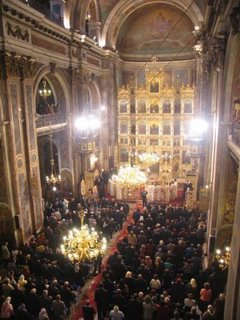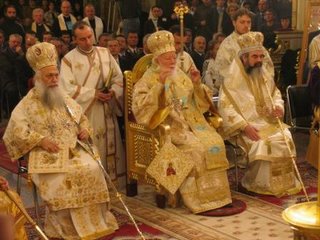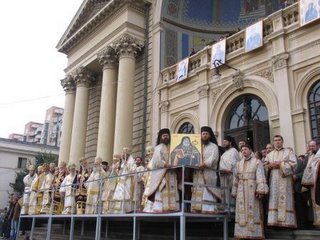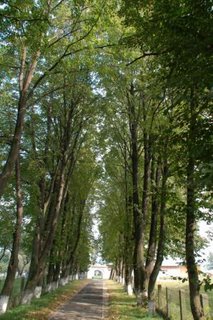October 10, 2005: Life in the Village
City life is similar to city life almost anywhere now in the western world, of course with its own unique Romanian aspects regarding driving, retail goods available, etc., but it is life in the village that reveals the beauty of the land and of the people! To give you some background about the family, vFr. Viktor is a priest in the village, has two sons (Constantin has been acting as my guide showing me the treasures of their land), mother working in Italy (because good paying jobs are hard to find right now), and a daughter with her own family living in central Romania. They, like most in the village, have at least a few acres of land with a garden (cabbage, potatoes, onions, garlic, beans, tomatoes, peppers, corn, wheat, & other staples), fruit trees (plum & apple), grape vines, and animals (chickens, pigs, ducks, and many have a cow or horse).
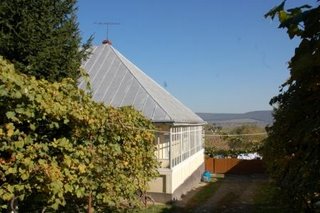

Almost every family grows & eats this good naturally or organically, because they've never had the means to "modernize" their agricultural methods...ironic isn't it, that their relative "poverty" has spared their land & their health the ravages of modern ag devastation (petrochemical pollution & land overusage) & the poison of manufactured foods (GMOs, etc.).
They use the animals to work the land or for transport, and of course for food. The people are so healthy, strong & don't have many of the physical, mental or psychological health problems we tend to confront in the US, whether it be from the stress/pressures of our pace of life or our diet (things aren't perfect here, they have their share of struggles). All families can food for during the off seasons, trade food stuffs with others in the village to round out their diet, make their own wine, liquers, process their own meets, & juices. My allergies have really subsided since coming here, I've slept better & had more energy than in a long time!
Work days start early and end whenever the job is done or the people feel like calling it quites, because most work on their land. They almost never work on Sundays, out of respect for the Day of the Resurrection, except to feed the animals. This is when families & friends usually get together and even small day trips are made to scenic spots for barbeques or visits to Holy Places. The village is like a family, and because I'm staying at the house of the village priest I've seen this almost every day, at any hour when sometime comes calling with a problem or need the benefactor gives whatever they can. There is much peace amongst the people. They are very humble, warm & sincere, lacking in any guile. Constantin told me, of course we're humble people, because outside invaders have humiliated us over the centuries with wars & devastation. Romanians are very hospitable too! Every house we've gone to or relative we've visited, I've been offered food, drink, shower, &/or a place to stay. One peculiarity about driving in Romania, especially through the countryside, is needing to know the common practice for the rules of the road...for example, they don't have strict guidelines or signals at all intersections (which can be rather hazardous in town) or as regimented traffic laws. I've been able to drive some on our tours, which has been fun (actually reminding me of driving video games growing up), having to dodge horse drawn carts, stopped or slow cars, people & oncoming traffic on the narrow roadways.
I could go on & on with more details, but I think you get the picture and I'm sure that you're weary of reading me ramble on...
I've included some photos from the farm as well as during a recent service at a neighboring village where Bishop Pimen celebrated the Liturgy for the renovation of the village church. They held the Liturgy outside due (which is common for large gatherings) because of the sheer number of people who attend. I was asked into the altar to take photos (& all of the priests were anxious to get copies)...so maybe I have a budding career as a professional photographer in Romania! : )
Labels: Romania


